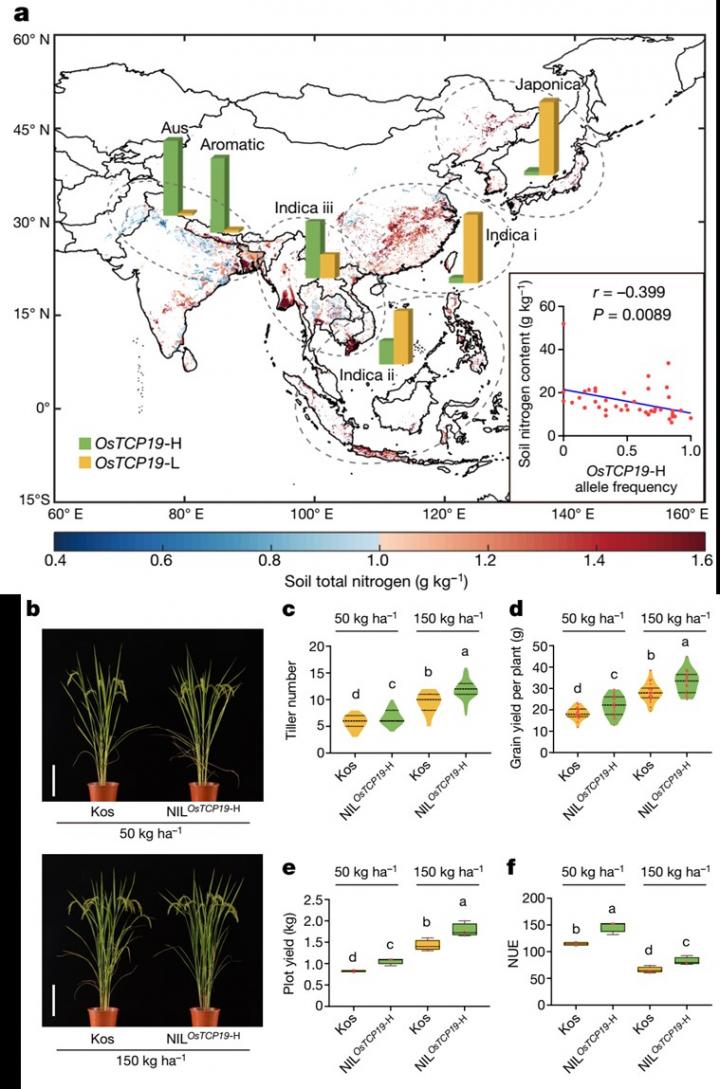
Credit: IGDB
Chinese scientists from the Institute of Genetics and Developmental Biology of the Chinese Academy of Sciences (CAS) have found a gene that plays an important role in helping rice adapt to low soil nitrogen.
Nitrogen fertilizer application is a strategic challenge for sustainable agriculture: On the one hand, it plays an indispensable role in increasing crop yields, thus ensuring global food security. On the other hand, it creates a severe threat to ecosystems. For this reason, breeding new crop varieties with high nitrogen use efficiency (NUE) is a high priority for both agricultural production and environmental protection.
Using a diversified rice population derived from different ecogeographical regions, the scientists carefully evaluated how various agronomic traits responded to nitrogen in fields with different nitrogen supply conditions. They further performed a genome-wide association study (GWAS). Surprisingly, only one very significant GWAS signal was identified. The detail mechanisms how OsTCP19 works in regulating rice tillering were also characterized.
More interestingly, by analyzing global soil nitrogen content data, the researchers found a strong correlation between the allelic variation of OsTCP19 and global soil nitrogen-content distribution. OsTCP19-H, the high NUE allele, was highly preserved in rice types grown in nitrogen-poor regions, but has been lost in rice types grown in nitrogen-rich regions.
Notably, OsTCP19-H is also highly prevalent in wild rice–the ancestor of modern cultivated rice–which was grown in natural soil without artificial fertilizer input. As modern rice cultivars are mainly grown with a bountiful nitrogen supply, OsTCP19-H has thus largely been lost. Therefore, breeding high-yield crops with decreased nitrogen input can be realized by bringing OsTCP19-H back to modern cultivars.
Indeed, OsTCP19-H introgression into modern cultivars can improve nitrogen use efficiency 20-30% under conditions of decreased nitrogen supply. For this reason, modern cultivated rice may be greatly improved by bringing the lost allele back through the use of poor-soil landraces that largely preserve the valuable genes of wild rice.
“This is truly groundbreaking. It will have implications not only for the basic understanding of how plants/rice works, but also has enormous implications for reducing fertilizer use,” said Prof. Dale Sanders, director of the John Innes Centre in the UK.
The findings represent an important breakthrough in plant nutrition research and high NUE breeding and will greatly benefit sustainable agriculture. The work not only offers novel insights about the genetic basis for the geographic adaption of cultivated rice to soil fertility, but also gives a hint about efficiently dissecting other complex traits.
###
The work, entitled “Genomic basis of geographic adaptation to soil nitrogen in rice,” was published in Nature on Jan. 6, 2021. It was funded by the Strategic Priority Research Program of CAS, the National Science Foundation of China, the Ministry of Science and Technology, and the Major Programme of Guangdong Basic and Applied Research.
Media Contact
Dr. CHU Chengcai
[email protected]
Related Journal Article
http://dx.





